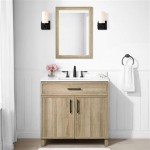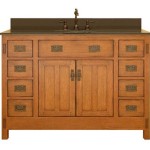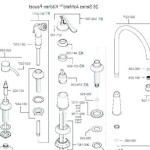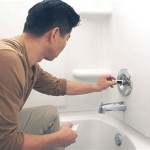Wall Mount Bathroom Sink Bracket: A Comprehensive Guide
Wall-mounted bathroom sinks offer a sleek, modern aesthetic and can be a practical solution for smaller spaces or those seeking a minimalist design. Crucial to the functionality and safety of these installations are the wall mount bathroom sink brackets. These brackets provide the necessary support to hold the sink securely in place, bearing the weight of the fixture itself, water, and any items placed within the sink basin. Understanding the different types of brackets available, their installation requirements, and considerations for load-bearing capacity is essential for a successful and safe installation.
This article provides a comprehensive overview of wall mount bathroom sink brackets, covering their various types, material considerations, installation procedures, and the critical aspects of weight capacity and safety. Emphasis will be placed on ensuring proper installation to prevent potential failures and maintain the longevity of the sink and supporting structure.
Types of Wall Mount Bathroom Sink Brackets
Several types of wall mount bathroom sink brackets are available, each designed for specific sink styles, wall construction, and load-bearing requirements. Choosing the appropriate bracket is crucial for ensuring the sink's stability and preventing damage to the wall or sink.
Traditional Brackets: These are typically L-shaped brackets made from steel or cast iron. They are attached to the wall studs using screws or bolts and offer a simple and robust support system. Traditional brackets are often used for heavier sinks or when the wall construction requires a more substantial anchor.
The design of traditional brackets often involves a vertical arm that attaches to the wall and a horizontal arm that extends outwards to support the underside of the sink. The horizontal arm may have a lip or flange to provide a secure seating surface for the sink. Some traditional brackets are adjustable, allowing for fine-tuning of the sink's height and levelness.
Concealed Brackets: These brackets are designed to be hidden from view after installation, offering a cleaner, more minimalist appearance. They are typically made from steel and are embedded within the wall during construction or renovation. Concealed brackets provide a strong and discreet support system.
Concealed brackets often require more precise installation as they need to be integrated into the wall framing. The installation process typically involves creating a recess in the wall studs to accommodate the bracket. Once the bracket is in place, the wall is finished, concealing the bracket behind the wall surface.
Floating Sink Brackets: Similar to concealed brackets, floating sink brackets are designed to create the illusion of a sink floating without visible support. These brackets are typically made of heavy-duty steel and are engineered to distribute the weight of the sink evenly across the wall. They also require precise installation and often necessitate reinforcing the wall structure.
Floating sink brackets often involve a combination of horizontal and vertical supports that are integrated into the wall framing. The horizontal supports extend outwards to support the sink, while the vertical supports anchor the bracket to the wall studs. The design aims to maximize load-bearing capacity while minimizing visible hardware.
Adjustable Brackets: These brackets offer flexibility in adjusting the sink's height and position after installation. They are particularly useful for accommodating uneven walls or specific user preferences. Adjustable brackets typically incorporate a mechanism that allows for vertical adjustment of the sink support arm.
Adjustable brackets can be found in both traditional and concealed designs. The adjustment mechanism typically involves a threaded rod or a series of slots and bolts that allow for fine-tuning of the sink's height. These brackets can be particularly useful for installations where accessibility is a concern, as the sink height can be adjusted to meet the needs of different users.
The selection of the bracket type depends on factors such as the sink's weight, size, and design, as well as the wall construction and desired aesthetic. Consulting with a professional plumber or contractor is recommended to determine the most appropriate bracket type for a specific installation.
Material Considerations and Load-Bearing Capacity
The material used in the construction of wall mount bathroom sink brackets significantly impacts their strength, durability, and resistance to corrosion. The load-bearing capacity of the bracket is directly related to the material's properties and the bracket's design.
Steel: Steel is a common material for sink brackets due to its high strength and relatively low cost. Steel brackets are typically coated with a protective finish to prevent rust and corrosion. The thickness and grade of the steel used in the bracket's construction determine its load-bearing capacity.
Steel brackets are often manufactured using processes such as welding and stamping. Welding is used to join different components of the bracket, while stamping is used to create the desired shape and form. The quality of the welding and stamping processes affects the bracket's overall strength and durability.
Stainless Steel: Stainless steel offers superior corrosion resistance compared to regular steel, making it a suitable choice for wet environments like bathrooms. Stainless steel brackets are typically more expensive than steel brackets but offer a longer lifespan and require less maintenance.
Stainless steel brackets are often used in high-end bathroom installations where aesthetics and durability are paramount. The material's resistance to rust and staining ensures that the bracket maintains its appearance over time. Different grades of stainless steel offer varying levels of corrosion resistance, so it is important to choose a grade that is appropriate for the specific application.
Cast Iron: Cast iron is a heavy and durable material that is often used for traditional sink brackets. Cast iron brackets provide excellent support for heavy sinks and can withstand significant loads. However, cast iron is susceptible to rust and requires a protective coating to prevent corrosion.
Cast iron brackets are typically manufactured using a casting process, where molten iron is poured into a mold to create the desired shape. The casting process allows for the creation of complex shapes and designs. Cast iron brackets are often finished with a durable paint or powder coating to protect them from rust and corrosion.
Load-Bearing Capacity: Determining the load-bearing capacity of the bracket is crucial for ensuring the sink's safety and preventing failures. The manufacturer's specifications should be consulted to determine the maximum weight the bracket can support. This weight should exceed the combined weight of the sink, water, and any items placed in the sink.
The load-bearing capacity of a bracket is influenced by factors such as the material's strength, the bracket's design, and the method of attachment to the wall. Brackets that are attached to wall studs provide greater load-bearing capacity than brackets that are attached to drywall alone. It is important to ensure that the wall construction is capable of supporting the weight of the sink and the bracket.
It's crucial to consider not just the static weight but also the dynamic load. A dynamic load refers to the additional force exerted on the bracket when the sink is in use, such as when someone leans on it or when items are dropped into the sink. The bracket should be able to withstand these dynamic loads without failing.
Overloading the bracket can lead to structural failure, which can result in damage to the sink, the wall, and potentially cause injury. Regularly inspecting the brackets for signs of wear and tear, such as cracks or rust, is essential for maintaining their structural integrity. If any signs of damage are detected, the brackets should be replaced immediately.
Installation Procedures and Safety Precautions
Proper installation of wall mount bathroom sink brackets is paramount for ensuring the sink's stability and preventing accidents. The installation process involves several steps, including locating wall studs, attaching the brackets securely, and leveling the sink.
Locating Wall Studs: Wall studs are vertical framing members that provide structural support for the wall. Locating wall studs is crucial for ensuring that the brackets are securely anchored. A stud finder can be used to locate the studs accurately. Alternatively, the traditional "tap test" can be used to identify studs - solid thuds indicate a stud, while hollow sounds suggest drywall only.
When installing brackets, it is essential to attach them directly to the wall studs. Attaching brackets to drywall alone is not sufficient to support the weight of the sink. If studs are not located where needed, a horizontal blocking can be installed between the studs to provide a solid anchoring point.
Attaching the Brackets: The brackets should be attached to the wall studs using appropriate fasteners, such as screws or bolts. The size and type of fasteners should be appropriate for the weight of the sink and the thickness of the wall studs. Follow the manufacturer's instructions for the recommended fastener size and type.
Pre-drilling pilot holes before inserting the fasteners can help prevent the wood from splitting. Ensure that the fasteners are driven in straight and tight. Avoid over-tightening the fasteners, as this can damage the wood or strip the threads.
Leveling the Sink: Once the brackets are securely attached to the wall, the sink can be placed on the brackets. Use a level to ensure that the sink is level both horizontally and vertically. If the sink is not level, shims can be used to adjust its position.
Adjustable brackets, as previously mentioned, offer an easier process for leveling the sink. However, even with adjustable brackets, it is important to verify the levelness of the sink and make any necessary adjustments.
Safety Precautions: Always wear safety glasses to protect your eyes from debris. Use caution when working with power tools and follow the manufacturer's instructions. If you are not comfortable performing the installation yourself, it is recommended to hire a qualified plumber or contractor.
Before starting the installation, turn off the water supply to the bathroom. This will prevent water damage in case of accidental leaks. Clear the work area and ensure that there is adequate lighting. Have all necessary tools and materials readily available before starting the installation.
After the installation is complete, inspect the sink and brackets thoroughly to ensure that they are securely attached and level. Test the sink by filling it with water and checking for leaks. If any leaks are detected, tighten the plumbing connections and retest.
Regularly inspect the brackets for signs of wear and tear, such as cracks or rust. If any damage is detected, the brackets should be replaced immediately. By following these installation procedures and safety precautions, a secure and functional wall-mounted bathroom sink installation can be achieved.

Wall Mount Sink Brackets Teak Bathroom Model Furniture

Plumbpro Wall Mount Lavatory Bracket 00314 The Home Depot

Cast Iron Bracket For Standard China Wall Hung Sinks Dea Bathroom Machineries

Wall Mounted Towel Bracket For Houston And Atlanta Sinks Denmark

K 1808 P Sink Brackets Kohler

Floating Sinks Brackets System Only Wetstyle

Height Adjustable Wash Basin Bracket Aicube
Fixing Kit For Wall Mounted Bathroom Wash Basin Sink S Plugs Nuts Bracket Ee Malaysia

Gerber Plumbing Part 99161 Wall Hanger For S Hung Bathroom Sinks And 27 740 Urinal In Stainless Steel Brackets Home Depot Pro

Bracket For Washbasins Bolisitalia Com In 2024 En Suite Shower Room Shelves Wash Basin
Related Posts







